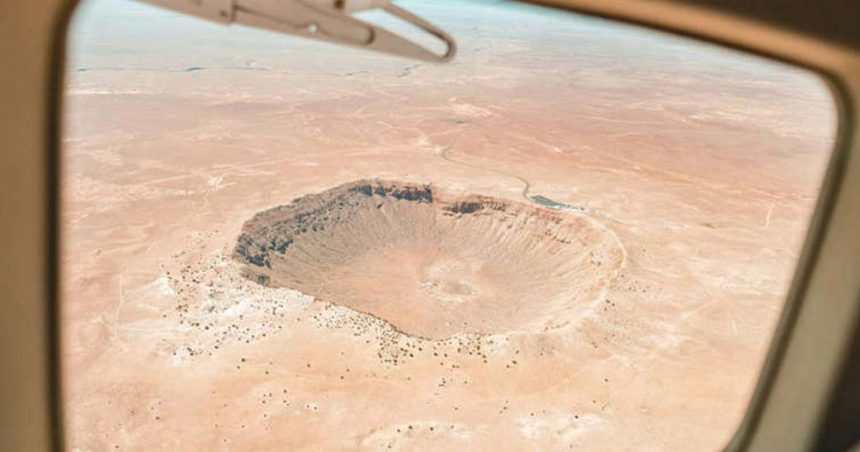In 1993, scientists made a groundbreaking discovery of a massive impact crater hidden beneath the Earth’s surface in the United States. This crater, known as the Chesapeake Bay impact crater, is larger than the Grand Canyon and has intrigued the scientific community ever since.
The Discovery
About 35 million years ago, a colossal asteroid struck the ocean off the East Coast of North America, forming the Chesapeake Bay impact crater in Virginia and Maryland. With a diameter of 25 miles, it ranks as the largest known impact crater in the US and the 15th largest globally.1
Geological Impact
The catastrophic asteroid impact triggered fires, earthquakes, and a massive tsunami, leaving behind an ejecta layer that spread across 4 million square miles. This layer contains tektites and shocked zircon crystals, showcasing the extreme energy released during the impact event.
Significance of the Crater

The Chesapeake Bay impact crater provides crucial insights into Earth’s geological and biological history. Dr. Marc Biren highlights the importance of accurate dating of impact events in understanding Earth’s past. Studying such impact events sheds light on planetary development and its impact on life’s history.
Other Significant Impact Craters
Aside from the Chesapeake Bay crater, several other impact sites worldwide demonstrate the destructive power of asteroid impacts.
Vredefort Crater
The Vredefort Crater in South Africa, the largest known on Earth, formed around 2 billion years ago from an asteroid impact. Measuring up to 186 miles in diameter, this impact reshaped the region’s geology, creating a ring of mountains and providing insights into early planetary history.
Chicxulub Crater
The Chicxulub Crater on the Yucatan Peninsula in Mexico, formed 66 million years ago, is famous for its association with the mass extinction event that led to the demise of non-avian dinosaurs. This impact, approximately 112 miles wide, caused global environmental changes with long-lasting effects on life and climate.
Sudbury Basin
The Sudbury Basin in Ontario, Canada, created 1.8 billion years ago, offers rich deposits of minerals like nickel and copper. The impact from an asteroid or comet around 6 to 9 miles in diameter left a crater now heavily eroded but originally measuring about 93 miles across.
Barringer Crater
The Barringer Crater, also known as Meteor Crater, in Arizona, formed around 50,000 years ago from a nickel-iron meteorite impact. This well-preserved crater, about 0.75 miles wide and 570 feet deep, serves as a valuable site for research and public education on impact events.
Lonar Crater
The Lonar Crater in Maharashtra, India, unique for its basaltic rock formation, resulted from a meteorite impact 35,000 to 50,000 years ago. With a diameter of 1.8 miles and 500 feet deep, this crater stands as a crucial site for studying impact processes in volcanic terrains.
Wolfe Creek Crater
The Wolfe Creek Crater in Western Australia, formed around 300,000 years ago by a meteorite, offers a well-preserved structure for studying impact craters and has become a popular tourist destination.
Hidden Impact Craters
While the Chesapeake Bay crater stands as the largest in the US, several significant impact sites globally, like the Vredefort Crater in South Africa, provide crucial insights into Earth’s violent past.
Unseen Catastrophes
Over 190 confirmed impact structures on Earth, as listed by the PASSC at the University of New Brunswick, offer valuable data for understanding our planet’s history and anticipating future impacts despite erasure by Earth’s dynamic processes.
Conclusion
Exploring impact craters, including the Chesapeake Bay crater, unveils the dramatic events that have shaped Earth’s surface. With each site providing unique insights into planetary formation and the history of life, ongoing scientific study promises a deeper understanding of Earth’s dynamic history within the solar system.
Sources
- “Massive crater 3x larger than the Grand Canyon discovered in U.S.” The Bright Side. Joshua Shavit. July 8, 2024.
- “10 Earth impact craters you must see.” Space. Daisy Dobrijevic. November 4, 2022.
- “What are the largest impact craters on Earth?” Live Science. Donavyn Coffey February 15, 2022.
- “Scientists Say They’ve Found the Largest Asteroid Impact Crater Hiding in Plain Sight.” Popular Mechanics. Tim Newcomb. September 1, 2023.






